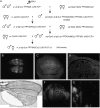Identification of genes affecting wing patterning through a loss-of-function mutagenesis screen and characterization of med15 function during wing development
- PMID: 20233856
- PMCID: PMC2881146
- DOI: 10.1534/genetics.109.113670
Identification of genes affecting wing patterning through a loss-of-function mutagenesis screen and characterization of med15 function during wing development
Abstract
The development of the Drosophila melanogaster wing depends on the correct regulation of cell survival, growth, proliferation, differentiation, and pattern formation. These processes, and the genes controlling then, are common to the development of epithelia in many different organisms. To identify additional genes contributing to wing development we have carried out a genetic screen in mosaic wings carrying clones of homozygous mutant cells. We obtained 12 complementation groups corresponding to genes with a proven role in wing formation such as smoothened, thick veins, mothers against dpp, expanded, and fat and 71 new complementation groups affecting the pattern of veins and the size of wing. We mapped one of these groups to the mediator15 gene (med15), a component of the Mediator complex. We show that Med15 and other members of the Mediator complex are required, among other processes, for the transcription of decapentaplegic target genes.
Figures









Similar articles
-
A gain-of-function screen identifying genes required for vein formation in the Drosophila melanogaster wing.Genetics. 2006 Nov;174(3):1635-59. doi: 10.1534/genetics.106.061283. Epub 2006 Sep 15. Genetics. 2006. PMID: 16980395 Free PMC article.
-
Decapentaplegic and growth control in the developing Drosophila wing.Nature. 2015 Nov 19;527(7578):375-8. doi: 10.1038/nature15730. Epub 2015 Nov 9. Nature. 2015. PMID: 26550824
-
Coupling between dynamic 3D tissue architecture and BMP morphogen signaling during Drosophila wing morphogenesis.Proc Natl Acad Sci U S A. 2019 Mar 5;116(10):4352-4361. doi: 10.1073/pnas.1815427116. Epub 2019 Feb 13. Proc Natl Acad Sci U S A. 2019. PMID: 30760594 Free PMC article.
-
Pattern formation in the Drosophila wing: The development of the veins.Bioessays. 2003 May;25(5):443-51. doi: 10.1002/bies.10258. Bioessays. 2003. PMID: 12717815 Review.
-
Drawing lines in the Drosophila wing: initiation of wing vein development.Curr Opin Genet Dev. 2000 Aug;10(4):393-8. doi: 10.1016/s0959-437x(00)00102-7. Curr Opin Genet Dev. 2000. PMID: 10889058 Review.
Cited by
-
Understanding Obesity as a Risk Factor for Uterine Tumors Using Drosophila.Adv Exp Med Biol. 2019;1167:129-155. doi: 10.1007/978-3-030-23629-8_8. Adv Exp Med Biol. 2019. PMID: 31520353 Review.
-
In the line-up: deleted genes associated with DiGeorge/22q11.2 deletion syndrome: are they all suspects?J Neurodev Disord. 2019 Jun 7;11(1):7. doi: 10.1186/s11689-019-9267-z. J Neurodev Disord. 2019. PMID: 31174463 Free PMC article. Review.
-
Combinatorial control of temporal gene expression in the Drosophila wing by enhancers and core promoters.BMC Genomics. 2012 Sep 20;13:498. doi: 10.1186/1471-2164-13-498. BMC Genomics. 2012. PMID: 22992320 Free PMC article.
-
Stem Cell Proliferation Is Kept in Check by the Chromatin Regulators Kismet/CHD7/CHD8 and Trr/MLL3/4.Dev Cell. 2019 May 20;49(4):556-573.e6. doi: 10.1016/j.devcel.2019.04.033. Dev Cell. 2019. PMID: 31112698 Free PMC article.
-
The Mediator CDK8-Cyclin C complex modulates Dpp signaling in Drosophila by stimulating Mad-dependent transcription.PLoS Genet. 2020 May 28;16(5):e1008832. doi: 10.1371/journal.pgen.1008832. eCollection 2020 May. PLoS Genet. 2020. PMID: 32463833 Free PMC article.
References
-
- Ashburner, M., 1989. Drosophila. A Laboratory Manual. Cold Spring Harbor Laboratory Press, Cold Spring Harbor, NY.
-
- Bier, E., 2000. Drawing lines in the Drosophila wing: initiation of wing vein development. Curr. Opin. Genet. Dev. 10 393–398. - PubMed
Publication types
MeSH terms
Substances
LinkOut - more resources
Full Text Sources
Molecular Biology Databases
Research Materials

